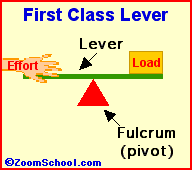
Monday, April 29, 2013
SIMPLE MACHINES
Simple machines
make work easier for us by allowing us to push or pull over increased distances.
There are SIX simple
machines:
|
Type
|
Example
|
Activity |
|
1. Pulley
- How Stuff Works
A pulley is a simple machine that
uses grooved wheels and a rope to raise, lower or move a load.
|
|
|
|
2. Lever - Enchanted Learning animations
A lever is a stiff bar that
rests on a support called a fulcrum which lifts or moves loads.
|
||
|
A wedge is an object with at least
one slanting side ending in a sharp edge, which cuts material apart.
|
||
|
A wheel with a rod, called
an axle, through its center lifts or moves loads.
|
||
|
An inclined plane is a slanting
surface connecting a lower level to a higher level.
|
||
|
A screw is an inclined plane
wrapped around a pole which holds things together or lifts materials.
|
LEVERS
Levers are one of the basic tools that were probably used in prehistoric
times. Levers were first described about 260 BC by the ancient Greek
mathematician Archimedes (287-212 BC).
A lever is a simple machine that makes work easier for use; it involves moving a load around a pivot using a force. Many of our basic tools use levers, including scissors (2 class 1 levers), pliers (2 class 1 levers), hammer claws (a single class 2 lever), nut crackers (2 class 2 levers), and tongs (2 class 3 levers).
In a Type 1 Lever, the pivot (fulcrum) is between the effort and the
load. In an off-center type one lever (like a pliers), the load is
larger than the effort, but is moved through a smaller distance.
Examples of common tools (and other items) that use a type 1 lever include:
In a Type 2 Lever, the load is between the pivot (fulcrum) and the effort.
Examples of common tools that use a type 2 lever include:
In a Type 3 Lever, the effort is between the pivot (fulcrum) and the load.
Examples of common tools that use a type 3 lever include:
A lever is a simple machine that makes work easier for use; it involves moving a load around a pivot using a force. Many of our basic tools use levers, including scissors (2 class 1 levers), pliers (2 class 1 levers), hammer claws (a single class 2 lever), nut crackers (2 class 2 levers), and tongs (2 class 3 levers).
 A Type 1 Lever. |
 A Type 2 Lever. |
 A Type 3 Lever. |
 A Type 1 Lever. |
| Item | Number of Class 1 Levers Used | |
|---|---|---|
| see-saw | a single class 1 lever | |
| hammer's claws | a single class 1 lever | |
| scissors | 2 class 1 levers | |
| pliers | 2 class 1 levers | |
 A Type 2 Lever. |
| Item | Number of Class 2 Levers Used | |
|---|---|---|
| stapler | a single class 2 lever | |
| bottle opener | a single class 2 lever | |
| wheelbarrow | a single class 2 lever | |
| nail clippers | Two class 2 levers | |
| nut cracker | Two class 2 levers | |
 A Type 3 Lever. |
| Item | Number of Class 3 Levers Used | |
|---|---|---|
| fishing rod | a single class 3 lever | |
| tweezers | Two class 3 levers | |
| tongs | Two class 3 levers | |
Friday, April 26, 2013
Subscribe to:
Comments (Atom)













